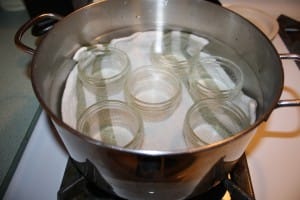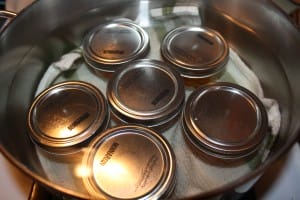How to Make Jam – The Basics
Welcome to How to Make Jam!
Whether you’re making jam for the first time or you’re looking for a little refresher, you’ll find a good overview of jam making here. I hope it will provide the info and confidence you need to make great jams. For this article, I’m focusing on jams using commercial pectin.

Also Read: Three Types of Strawberry Jam Recipes, Troubleshooting Jams & Jellies, Types of Pectin
Here are the different sections you’ll find in this post. Go directly to the section you’re most curious about, or review it all.
Types of Jams/Spreads/Preserves
Try Freezer Jam First – No Canning Needed
Key Ingredients Needed for Jam Making
Types of Pectin
Substituting Pectin in a Recipe
Equipment Needed for Jam Making
Sterilizing and Hot Water Bath Canning
General Tips for Getting Started
Where to Find Credible Recipes
My Favourite Jam & Jelly Recipes
Other Canning Articles
Types of Jams/Spreads/Preserves
There are a lot of types of preserves you can spread on your morning toast. Here are some standard definitions to help you identify what to look for when deciding what to make. Depending on the fruit and the type of pectin you choose, these preserves can be made sugar free, low sugar or full sugar.
Jams are thick, sweet spreads made by cooking crushed or chopped fruits. Jams tend to hold their shape but are generally less firm than jelly. Strawberry Rhubarb Low Sugar Jam, Cranberry Mandarin Jam, Mandarin Jam, Three types of Strawberry Jam
Jellies are spreads made with fruit juice only, no fruit pieces. A good jelly is clear, firm enough to hold its shape and quivers when moved. Grape Jelly, Hot Pepper Jelly
Freezer Jams are made from crushed uncooked fruit that is sweetened and mixed with pectin to create a spread that must be stored in the fridge or freezer for extended time. It is softer than traditional cooked jams. (Note: cooked jams can also be stored in the freezer). Strawberry Freezer Jam
Conserves are jam-like spreads made from a mixture of fruits and items like nuts, raisins or coconut.
Marmalades are soft fruit jellies containing small pieces of citrus fruit or peel.
Butters are sweet, smooth spreads made by cooking fruit pulp or puree with sugar for a long time to thicken. Spices are often added.
Chutneys are like jam with the addition of spices and vinegar. They’re typically less sweet and often paired with savory dishes as a condiment.
Specialty Spreads are spreads that are used like traditional jams and jellies but are made in non-traditional ways. For example, chia seed jam. Strawberry Rhubarb Chia Seed Jam
Try Freezer Jams First – No Canning Needed
The easiest and one of the tastiest jams ever! I love this jam. It tastes so fruity and can be made with just about any kind of fresh or frozen fruit. It’s perfect for first time jam making because it takes 30 minutes, there’s no cooking or canning involved and it tastes amazing. It makes a small batch and is perfect for getting kids involved.
This jam is softer than traditional jam and extra jars must be stored in the freezer.
Try this low sugar Strawberry Freezer Jam recipe. You can substitute the strawberries in this recipe with other fruit or use a combination of fruit.
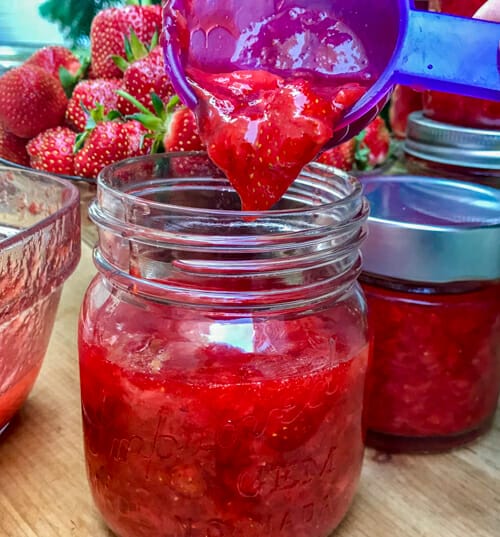
Ingredients Needed to Make Jam
Getting a good set – just the right amount of firmness – depends on the correct ratio of fruit, sugar, pectin and acid combined with heat. The sugar, pectin and acid varies with the type of fruit. For example a crab apple has plenty of pectin and acid, but not much sugar, while peaches are high in sugar but low in acid and pectin. To compensate, recipes may call for lemon juice (acid), a combination of fruit, certain types of pectin or a different amount of fruit than usual. That’s why it’s best to follow a tested, credible recipe to get the ratios right.
I recommend starting your jam making journey with commercial pectin. Pectin is a naturally sourced ingredient that you should not be concerned about using at all. There are several different types available, always read the ingredient list because some may include aspartame (which I try to avoid). Commercial pectin is easy to use, will lead to much more successful jam making and allow you to use different fruits and vary the sugar levels. Again, follow the recipe closely for the type of pectin recommended, as they are NOT interchangeable.
Here’s more about the roles of the different ingredients.
Fruit
- The flavour makers of jam, you’ll get the best flavour from local, seasonal fruit.
- Wash, drain, remove stems and damaged spots and prepare fruit as indicated in recipe.
- Use a mix or ripe and slightly under ripe fruit, using 1/4 amount under ripe fruit provides extra pectin and acid to help gelling.
- Choose frozen or raw fruit.
Sugar
- Sugar has many roles in jam. It sweetens the jam, helps pectin form a gel, helps preserve the colour, texture and flavour of jams on the shelf and extends the life of jams once opened. Sugar binds with water to make preserves less hospitable for pathogens.
- Alternative sweeteners (honey, agave, stevia, maple syrup, xylitol, etc.) do not have the same properties as granulated sugar. They will not have the same preservative effect.
- Preserves made with reduced sugar lose color quicker and have a shorter shelf life once opened.
- If reducing sugar, look for commercial pectin made specifically for this purpose.
Acid
- Acid is needed to activate the pectin so it can gel properly, without forming crystals.
- Without enough acid a gel will not form. Too much acid and your jam will weep (leak liquid).
- Not all fruit has enough acid so often recipes will include lemon or lime juice or citric acid (often 1Tbsp/1cup of juice).
Pectin
- Pectin is a natural product that gives jam it’s structure and firmness. Commercial pectin comes from apple or citrus fruit. It is a complex carbohydrate (a polysaccharide) naturally present in many plants. When mixed and heated with water, sugar and acid it has the ability to form a gel.
- There are many pectin varieties available today, some do not require sugar.
- Read ingredients to ensure you know what additional ingredients come in the box of pectin (eg. aspartame).
- Pectin breaks down over time so always check the Best Before Date – it actually matters with pectin!
- Pectin varieties are not interchangeable, use what is called for or substitute with changes.
- Doubling recipes is not recommended because it changes the time to properly activate pectin. To double a recipe, increase cooking time by 50% and test for gel set.
Types of Pectin
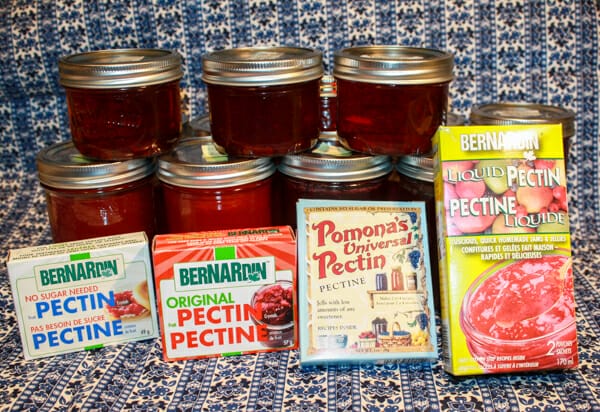
Pectin is a natural product that gives jam it’s structure and firmness. Every fruit naturally has pectin, it’s what holds fruit cells together. Some fruit has more pectin than others. Apple and citrus fruit have the highest amount of pectin and it is from these fruit that commercial pectin is made.
There are several types of pectin on the market, made by different manufacturers with Bernardin (Ball in the US) and Certo (Sure Jell in the US) being the most popular. I typically use Bernardin simply because that’s what my local store carries. For details on pectin read this Pectin Chart and A Closer Look at Pectin.
While the brand name of pectin doesn’t matter. The type of pectin does matter since they all work differently. Always use the type of pectin called for in a recipe, they are NOT interchangeable. Here are the types you’ll see called for in a recipe. If a recipe doesn’t specify, they are most likely referring to a box of regular powder pectin.
Regular Powder Pectin – Most commonly used. Produces classic jam. Easy, straightforward. Often uses more sugar than fruit. Requires cooking and hot water bath processing for shelf stable jam. Best for long lasting colour and flavour.
No Sugar Needed Powder Pectin – Easy to use, powdered pectin. Produces a classic jam texture with reduced sugar. Allows you to choose how much and what type of sweetener (honey, stevia, sugar, etc) to use. Most packages do include some form of sugar in the ingredients and some include artificial sweeteners like aspartame – read ingredient list carefully. Requires cooking and hot water bath processing for shelf stable jam. Because of reduced sugar, these jams will lose some color after 6 months or so.
Liquid Pectin – Easy to use liquid pectin that produces a classic jam or jelly texture. Requires as much or more sugar than fruit. Especially good for jelly. More expensive than powdered pectin. Requires cooking and hot water bath processing for shelf stable jam.
Freezer Jam Pectin – Easy to use and uses less sugar than fruit creating a very fruity tasting jam that is not as firm as regular jam. Different types are available, read ingredient and instructions carefully as some include artificial sweeteners and some require cooking. These cannot be safely canned to store on a shelf, extra jars must be stored in the freezer (hence the name).
Pomona’s Universal – A unique type of powdered pectin that requires little or no sugar. This pectin comes with two ingredient packages and requires a different process than other pectins, read instructions carefully. The final product is a little stiffer than classic jam. Requires cooking and hot water bath processing for shelf stable jam. Because it has reduced sugar, color of jam will darken over time. The only truly sugar free commercial pectin product.
My favourites are the No Sugar Added Pectin and Freezer Jam Pectin because I can control the sugar and I feel confident the ingredients in these products are safe. Always read the list of ingredients of pectin to make sure you’re happy with what’s listed. I try to avoid Aspartame whenever possible. I am not endorsed or paid by Bernardin, over the years, I’ve just found these products to be the ones I enjoy most.
For those of you who are regular jam makers, you know there are plenty of other options to choose from – chia seeds, homemade pectin, relying on naturally occurring pectin, extended cooking to reduce liquid, etc. Those are great options that are great to experiment with as people become more familiar with jam making and the function of the different ingredients.
The great thing about all these pectin packages is that they also come with easy to follow instructions. Buy a package and simply follow the instructions in the box. That is your best bet for jam making success. Those recipes are tried and true for that specific product.
Can I Substitute Pectin in a Recipe?
Not unless you make modifications. So for first timers, your best bet is to use a recipe for the pectin you have.
Every pectin type is made differently and requires different processes and ingredients to make them work properly. Follow the instructions and use the type of pectin recommended in a recipe. If a recipe calls for regular pectin or just says pectin – assume they are referring to the regular powdered pectin.
If you must, here’s how to substitute powdered pectin for liquid pectin.
Equipment Needed for Jam Making

Canning jars with lids
Canner or large pot
Jar lifter
Magnetic wand
Head Space Measure & Bubble Popper
Funnel
Clean cloth for wiping rim
Canning jars with lids
For the best results and safe canning, please use specifically designed canning jars and sealing lids. The jars can be reused over and over again, but the sealing part of the lid should be replaced every time you can a new batch to ensure a tight seal and no mold.
Canner or Large Pot
You don’t need the big enamel canning pot that you’ve seen proudly displayed by avid canners. When I’m making a small batch of jam, I just use my big soup pot. I line the bottom of the pot with a wash cloth or silicone trivet, add my jars being sure to leave space between them and boil away. The cloth prevents them from clinking together and bouncing on the bottom. Just make sure there’s about 1 inch of water above the rim of the jars.
The Jar lifter, Magnetic wand , Head Space Measure & Bubble Popper and the Funnel
You can make jam without these three magical tools, but I really love having them when jamming. They make the job easier and cleaner. Read all about my love for these three tools and how to use them in this article on Three Essential Canning Tools.
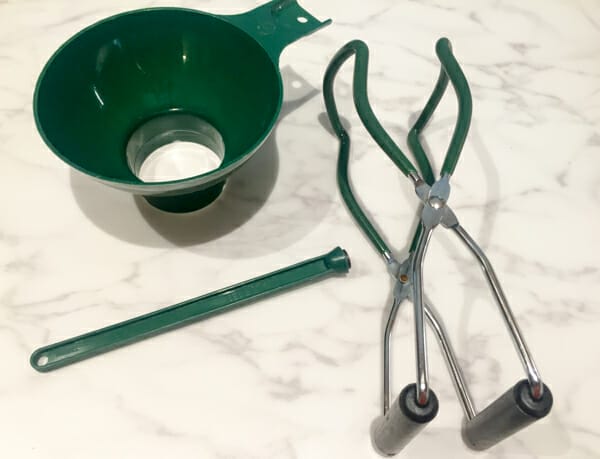
Following the instructions to get the correct headspace in a jar is actually pretty important. Headspace is the space between the top of the jam and the bottom of the flat part of the lid. During the water bath process, the air that is left in this space gets sucked out and then the lid seals tight so no air can get back in. If there is too much space, not all the air can get sucked out which means air stays in the jar, this air may contain mold or bacteria that can cause jam to spoil. If there is not enough headspace, then jam might get sucked out during the process. That means bits of jam will get stuck under the lid and you might not get a tight seal which can jeopardize the jam either right away or several weeks or months after you’ve stored it. In other words – follow the recipe instructions and fill the jar so you have the correct headspace. The headspace measuring tool is a good tool to help you identify the correct level. It also doubles as a tool to remove any trapped air bubbles.

Sterilizing and Hot Water Bath Canning
Do I have to? Yes, you have to properly process jam to store them safely without worry. This is the part that often freaks people out. But it is no big deal.
Sterilizing jars simply means boiling empty jars in water.
Hot Water Bathing means boiling jars filled with jam in water.
Yes, it is important. It creates a strong seal that will last for years. It prevents mold. It prevents yeast and offers peace of mind. It only takes 5 or 10 minutes to hot water bath your jars – just do it!
Sterilizing Jars
Sterilizing and heating jars before filling with hot jam ensures there’s nothing in those jars that will make the product spoil. It also heats the jars so that your hot jam goes into a hot jar to prevent any cracking in glass.
Also, the National Center for Home Food Preservation clearly states that if your jam is going in a hot water bath for 10 minutes or more you don’t need to sterilize your jars first. They should be cleaned and hot (always pour hot jam into a hot jar).
Get the step by step instructions here: Sterilizing Jars
Hot Water Bath Canning
Water bathing (boiling filled jars in water) ensures that if any microorganisms sneak in during the process they’ll be eliminated. It also seals the jars to provide a really tight seal so you’ll never end up with moldy jam or lids that pop off.
Get step by step instructions here: Hot Water Bath Canning
The sterilizing step can be skipped if you hot water bath your jam jars for 10 minutes or more.
If you really, really want to avoid these steps you can freeze any cooked jam just like you would freezer jam.
General Jam Making Tips
A good recipe will outline all the steps you’ll need to make your preserve. Step one is finding a great recipe, see below for where to find well tested recipes. The following are a few general tips to help you be more efficient and successful.
- Organize and assemble everything you need before you begin.
- Wash and check jars for cracks. Always prepare one or two extras, just in case.
- Always put hot foods in hot jars to prevent cracking.
- Use a pot that is large and as wide as possible to avoid splattering.
- Always add pectin and acid to these fruits: apricots, peaches, raspberries, pears, strawberries, sweet cherries, rhubarb, blueberries and prune plums.
- Use the pectin variety identified in a recipe; pectin varieties are not interchangeable.
- Use fresh pectin. The Best Before Date on pectin really does matter.
- Make one batch at a time. Doubling or tripling batches often results in soft or runny spreads.
- Add ½ teaspoon of butter or margarine to reduce foaming.
- Stir constantly to avoid burning.
- Do not overcook. Boiling too long or too slowly can destroy pectin and prevent it from gelling.
- It can take up to 48 hours or longer for jelly to set.
- If your jelly doesn’t set, use it as syrup for pancakes, waffles, ice cream or beverages. Or, follow the pectin manufacturer’s advice to try to re-make the jam or jelly.
- Process all types of preserves listed above, except freezer jam, in a hot water bath. This removes oxygen in the jar and ensures a tight seal that will last for a long time. Having the lid “pop” just from sitting on the counter is not sufficient. Yeast, mold or lids popping off during storage can be prevented with proper processing.
- If you don’t have time to make jams or jellies this summer, freeze seasonal fruit and make it later in the year.
Where To Find Credible Recipes
To be sure you’re getting current, safe and nutritious information, follow recipes and instructions from trusted, credible sources. The leading source of credible information and the organization regularly doing testing on safe canning practices is the US National Centre for Home Food Preservation.
Other sources I trust include:
Healthy Canning – recipes and tips
US State University Extension Offices
Certo – Home of Kraft – makers of Certo Pectin
Canadian Living – shares approved recipes
If you come across cookbook or blog authors, read their credentials, look at their general tone and how they write about canning and preserving. Anyone who has credible canning information should be referring to national standards and safe canning practices. Be suspicious of anyone offering shortcuts, information contrary to everything else you’ve read (eg. you see someone telling you can make shelf stable jam without canning) or sharing a 75 year old family recipe that has no canning involved. It’s better to be safe than sorry!
Troubleshooting Jams & Jellies
I am confident that you will knock it out of the park and make some amazing jam. Should you run into any difficulty check out this handy dandy troubleshooting chart I created. Trust me, all of us, no matter how experienced have jam making stories to tell!

My Favourite Jam & Jelly Recipes
Strawberry Rhubarb Jam with low sugar pectin
Other Canning Info
Canning Food – Water Bath or Pressure Can
Common Questions About Pressure Canners
Are you ready to get jamming!? Leave a comment and of course, if you make jam or jelly, share a photo on Instagram and tag @getgettys so I can see it and like it!
Getty Stewart is a Professional Home Economist, speaker, frequent media guest and writer dedicated to putting good food on tables and agendas. She is the author of several recipe books on enjoying and preserving fruit, Founder of Fruit Share, a mom and veggie gardener. Sign up to get articles by Getty delivered to your inbox. You’ll get recipes, practical tips and great food information like this.


